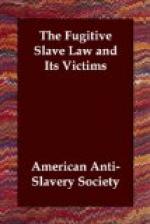Brashears, being advised by lawyers that Judge
Burgoyne had no right to issue his writ for the
slaves, and remembering Judge McLean’s decision
in the Rosetta case, made a return on the writ
of habeas corpus, that the slaves were
in the custody of the United States Marshal,
and, therefore, without his jurisdiction. This
returned the slaves to the custody of the Marshal.
By agreement, the parties permitted the slaves
to remain in the county jail during that day,
with the understanding that their examination
should commence the next morning, before Commissioner
Pendery. An inquest had been held on the body
of the child which was killed, and a verdict
was found by the jury charging the death of the
child upon the mother, who it was said would
be held under the laws of Ohio to answer the charge
of murder. An examination took place on Wednesday,
before the United States Commissioner. Time
was allowed their counsel to obtain evidence
to show that they had been brought into the State
at former times by their masters. A meeting of
citizens was held on Thursday evening, to express
sympathy with the alleged fugitives.
The Cincinnati Commercial of January 30, said:—The mother is of an interesting appearance, a mulatto of considerable intelligence of manner, and with a good address. In reply to a gentleman who yesterday complimented her upon the looks of her little boy, she said, “You should have seen my little girl that—that—[she did not like to say, was killed]—that died, that was the bird.”
The Cincinnati Gazette, of January 30, said:—We learn that the mother of the dead child acknowledges that she had killed it, and that her determination was to have killed all the children, and then destroy herself, rather than return to slavery. She and the others complain of cruel treatment on the part of their master, and allege that as the cause of their attempted escape.
The coroner’s jury, after examining the citizens present at the time of the arrest, went to the jail last evening, and examined the grandmother of the child—one of the slaves. She testified that the mother, when she saw they would be captured, caught a butcher knife and ran to the children, saying she would kill them rather than to have them return to slavery, and cut the throat of the child, calling on the grandmother to help her kill them. The grandmother said she would not do it, and hid under a bed.
The jury gave a verdict
as follows:—That said child was
killed by its mother,
Margaret Garner, with a butcher knife,
with which she cut its
throat.
Two of the jurors also
find that the two men arrested as
fugitives were accessories
to the murder.
“The murdered
child was almost white, and was a little girl
of rare beauty.”




